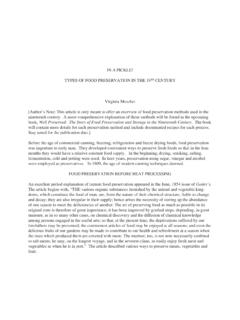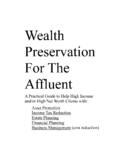Transcription of The Top Ten Myths About Historic Preservation by …
1 The Top Ten Myths About Historic Preservation by Ken Bernstein It often surprises me how many misunderstandings abound concerning Historic Preservation with some people closing their minds to Preservation based on inaccurate information, and others clinging to unrealistic expectations About the impacts or benefits of Preservation tools. As a starting point in clearing up these misconceptions, I offer up a top ten list of the most prevalent Myths About Historic Preservation . Myth #1: If a property gets designated as a Historic landmark, it s protected forever and can never be demolished. Fact: Landmark designation ensures a more thorough review of demolition proposals, but it does not prohibit demolition outright. In the City of Los Angeles, designation as a City Historic landmark ( Historic -Cultural Monument) allows the City s Cultural Heritage Commission to object to the issuance of a demolition permit, but only for 180 days.
2 The City Council may then extend the objection to demolition for an additional 180 days. Many East Coast cities, including New York, do actually prohibit demolition of their landmarks, but these cities also leave an exception for cases of demonstrated economic hardship. Even listing in the National Register of Historic Places, which sounds more elevated than mere local listing, does not provide for more iron-clad protection. Although demolition of a designated landmark in California additionally requires preparation of an Environmental Impact Report to assess the feasibility of alternatives to demolition, a truly determined property owner may be able to obtain approval to destroy even our most cherished landmarks. Myth #2: Historic designation will reduce my property values.
3 Fact: Study after study across the nation has conclusively demonstrated that Historic designation and the creation of Historic districts actually increase property values. Why? In part, Historic designation gives a neighborhood or an individual Historic site a cach that sets it apart from ordinary properties. Many buyers seek out the unique qualities and ambiance of a Historic property. Historic district designation gives potential homebuyers two rare and economically valuable assurances: that the very qualities that attracted them to their neighborhood will actually endure over time, and that they can safely reinvest in sensitive improvements to their home without fear that their neighbor will undermine this investment with a new monster home or inappropriate new development.
4 Myth #3: If my property is designated as a Historic site, I won t be able to change it in any way, and I don t want my property to become like a museum. Fact: Owners of designated Historic structures may make very significant changes to their structures. Historic Preservation laws, at their essence, are not meant to prevent change, but, rather, to manage change. The tool to manage change is the Secretary of Interior s Standards for Rehabilitation, the nationally accepted benchmark for evaluating changes to Historic structures. The Standards don t require that every element of a Historic site remain intact: you need not keep every doorknob! However, the most significant, or character-defining , Historic elements of a property should be retained.
5 New additions to the Historic property are allowed, but should be compatible with the site s Historic architecture. The Standards urge the repair of deteriorated Historic features, but do allow for replacement where the severity of deterioration leaves no other option. Myth #4: Preservation is only for the rich and elite, and for high-style buildings. Fact: Historic Preservation isn t just About house museums anymore. Today s Preservation movement is increasingly diverse: here in Los Angeles, the two newest Historic Preservation Overlay Zones (HPOZs) are in Pico-Union and Lincoln Heights, home to economically and ethnically varied populations. Preservation today also focuses not just on grandiose architectural landmarks, but on more modest sites of social and cultural significance.
6 Just look at the small Ralph J. Bunche House in South Los Angeles, boyhood home of the pioneering African-American diplomat, and Little Tokyo s Far East Caf , a beloved gathering place for the city s Japanese-American community both recently restored. Or, consider a current Preservation effort to save the modest Vladeck Center, a Boyle Heights building that was the center of the Jewish labor and immigrant resettlement movements of the 1930s. Such sites underscore that Preservation can be About the power of place found at sites containing rich social and cultural meaning. Myth #5: Historic Preservation is bad for business. Fact: Historic Preservation is at the very heart of our nation s most vibrant economic development and business attraction programs.
7 From Southern California examples such as Old Pasadena or San Diego s Gaslamp Quarter, to traditional, Historic southern cities such as Charleston or Savannah, to the recent boom in heritage tourism, today s economic development strategies no longer see Preservation and business development as competing values. The National Main Street Center, a program that uses Historic Preservation to revitalize town centers and neighborhood commercial districts, has actually tracked economic results in 1,700 Main Street communities nationally. These Preservation -based programs have created over 231,000 new jobs and resulted in over $17 billion in reinvestment to date, with every dollar spent on a Main Street program yielding $40 in economic reinvestment.
8 Myth #6: Preservation is more expensive than new construction This is certainly true at times, but, in fact, Historic Preservation is typically more cost effective than new construction. Why? Historic buildings certainly do sometimes need upgrades, but these are usually less expensive than the costs of building all-new foundations, structural systems, roofs and building finishes. The National Trust for Historic Preservation reports that in Chicago, where the public school system is now spending $ billion to upgrade facilities, bare-bones new construction is costing $155 per square foot -- but renovation is costing just $130. Here in Los Angeles, the State of California learned the potential savings from Historic Preservation in comparing the construction of two State Office Buildings: the new Ronald Reagan State Office Building on Spring Street at 3rd St.
9 , and the Junipero Serra State Office Building just two blocks away on Broadway at 4th St., in the renovated former flagship location of the Broadway Department Store. The Historic renovation not only reused and reinvigorated an important landmark from 1914, but it saved taxpayers money by delivering office space at About half the cost per square of the all-new Reagan building just a few years before. Myth #7: If I buy a Historic property, there s lots of government money available to help me fix it up While it doesn t necessarily cost more to renovate a Historic structure than to build anew, few large government or foundation grants are available to owners of Historic properties, and even those few typically limit eligibility to government agencies or non-profits.
10 What is available tends to be tax incentives for private owners of Historic buildings. Owners of sites listed in or eligible for the National Register of Historic Places may take advantage of a Federal Rehabilitation Tax Credit that provides a 20% tax offset for the cost of rehabilitation. National Register properties are also eligible to benefit from conservation easements binding legal agreements with Preservation organizations such as the Los Angeles Conservancy that can allow owners to claim a charitable deduction on their Federal income taxes. Finally, the State s Mills Act program, implemented by local governments throughout the State, including Los Angeles, allows Historic property owners to take often-significant property tax reductions.








